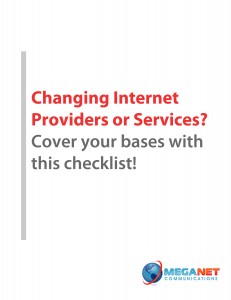Internet access providers are not created equally. Or to be more precise, they’re not built equally. Every provider develops and builds their network based on their client areas, and the services they feel are needed to provide the best access to their customers.
Some Internet providers, in particular larger national carriers, want to keep their customers on their network for as long as possible. That’s very understandable, and may have an even larger impact in the future as we see how Net Neutrality plays out. However, that may sometimes pose a problem if their network experiences congestion or even outages. Internet access customers of theirs may not be able to load certain websites, or access some services, based on where the outage or congestion might be.
A number of years back, a simple programming issue at the former MCI/WorldCom crippled traffic for many of their users across the United States for an entire weekend. More recently, an outage caused by faulty equipment on a national carrier’s network left many customers on the East Coast with slow or non-existent Internet access for nearly 24 hours. It doesn’t matter if you use DSL, dialup, T1, or Metro Ethernet fiber – if there’s a major network outage someplace on the Internet, it could impact you.
 Because of situations like this, some Internet providers will opt to use multiple carriers to provide the backbone of bandwidth for their clients. This allows them to have more than one path to various destinations around the Internet, and will help route their client traffic around problem areas. This way, if national carrier A has an outage, the Internet provider can then automatically send their client traffic through national carrier B to help route around that problem. Internet surfers would never know there was a major carrier issue in this type of instance.
Because of situations like this, some Internet providers will opt to use multiple carriers to provide the backbone of bandwidth for their clients. This allows them to have more than one path to various destinations around the Internet, and will help route their client traffic around problem areas. This way, if national carrier A has an outage, the Internet provider can then automatically send their client traffic through national carrier B to help route around that problem. Internet surfers would never know there was a major carrier issue in this type of instance.
When Internet providers maintain a multi-homed network, their clients also get the best possible path to their destination. All this means is that the Internet provider’s network equipment looks at where their customer’s Internet request is going, then determines the fastest way to get that request there and back by looking at the different carriers they have access to.
For example, let’s say a client in Massachusetts wants to look at a website that’s hosted in Texas. When that client’s computer sends the request to their Internet provider, that provider’s equipment will look at all of the various ways they could send that request, over the multiple carriers their network connects with. If the equipment determines that sending that request over Internet Carrier A, then that’s where it will direct the request to get to those servers in Texas and back in the quickest amount of time.
Now, let’s say this same request takes place, only Internet Carrier A is having a major outage. They’re trying to re-route all their traffic, but it’s causing congestion (think of how blocked up side roads get when there’s a detour on a major highway due to construction or an accident). The Internet provider the client in Massachusetts is using will automatically notice that using Carrier A, which normally is the best and fastest way, will cause their client’s request to be delayed or completely blocked (leading to the client not being able to load the web page they requested). When this happens, the Internet provider’s equipment will automatically look for the next best way to get that request to the server in Texas and back, which might now be by using Carrier C to carry their customer’s website request.
All of this happens in a matter of milliseconds, and is almost never noticed by the end user!
Now that many businesses are taking advantage of cloud services, it’s important that their Internet traffic always be able to reach it’s destination. Otherwise, employees may not be able to check email, salespeople might not be able to load their CRM and prospect, shipping departments might not be able to track the status of deliveries… the list goes on and on.
When thinking about looking for a new Internet access provider, consider whether or not the providers you’re researching offer a multi-homed network. The brand name of some larger carriers may be attractive based on their TV ads, but the network they maintain might actually cause your Internet services to slow down or be problematic at times since they don’t offer a multi-homed backbone. Be sure to inquire about their network and how they’d direct your traffic there was an outage somewhere along the way.
Is your business considering changing it’s Internet access for better speed or performance? Or are you perhaps thinking about changing providers to improve your uptime or costs? Download our free Internet Service Provider Change checklist to make sure your company is fully prepared to change your service or provider with ease and minimal service disruption.

